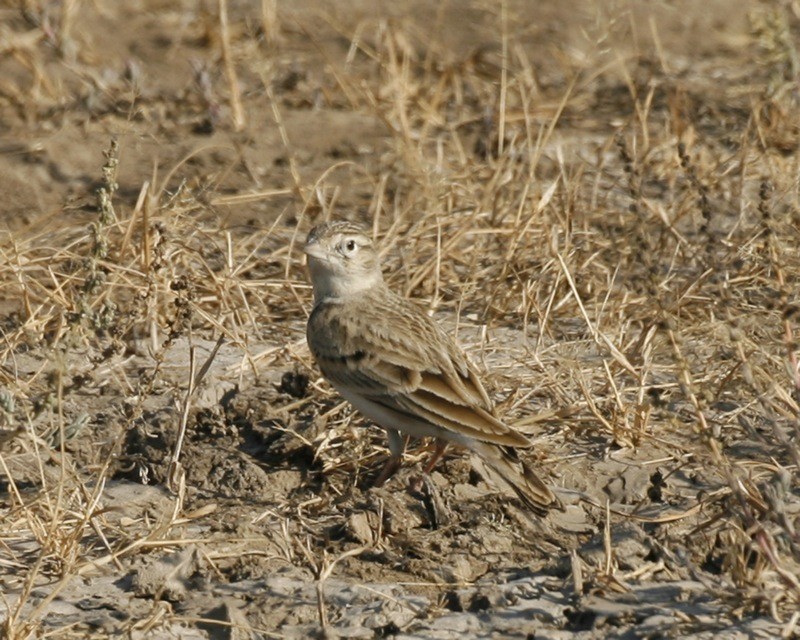Greater Short-toed Lark
A species of Greater Short-toed Larks and Allies Scientific name : Calandrella brachydactyla Genus : Greater Short-toed Larks and Allies
Greater Short-toed Lark, A species of Greater Short-toed Larks and Allies
Botanical name: Calandrella brachydactyla
Genus: Greater Short-toed Larks and Allies
Content
Description General Info
 Photo By Lip Kee Yap , used under CC-BY-SA-2.0 /Cropped and compressed from original
Photo By Lip Kee Yap , used under CC-BY-SA-2.0 /Cropped and compressed from original Description
Several subspecies have been named but there is considerable geneflow and the species itself forms part of a larger complex. This is a small pale lark, smaller than the skylark. It is dark-streaked greyish-brown above, and white below, and has a strong pointed bill that is pinkish with a grey culmen. It has a pale supercilium, dark patches on each side of its neck and a dark tail. Some birds in the west of the range have a rufous crown. The sexes are similar. The greater short-toed lark is paler than the Mongolian short-toed lark which also has a shorter bill. In winter they fly in large and compact flocks that swing in synchrony. Care must be taken to distinguish this species from other similar Calandrella larks, such as the lesser short-toed lark. The nominate form breeds in Europe (Iberia, France, Italy, the Balkans and Romania) and winters in Africa. Subspecies hungarica breeds in the eastern parts of Europe while rubiginosa breeds in north-western Africa. Subspecies hermonensis (sometimes including woltersi) breeds in Turkey, Syria and Egypt. Subspecies artemisiana (considered by some to be synonymous with longipennis) breeds in Asia Minor and winters in southern west Asia. Subspecies longipennis breeds in Ukraine, Mongolia and Manchuria and winters in South Asia mainly in the drier zone of north-western India. The song varies between a dry twittering and a more varied and imitative melody. Flocks will often fly together to water in the mornings at favourite spots. In the evenings they roost in open ground, with each bird squatting in a small depression made in the soil. 
Size
15 cm
Life Expectancy
5 years
Nest Placement
Ground
Feeding Habits
Greater Short-toed Lark primarily consume invertebrates in spring and switch to seeds and plant greens in other seasons. Their diet varies by location, favoring beetles, ants, hemipterans, and snails, alongside weedy seeds and grains. Nestlings are exclusively insectivorous, while fledglings start eating more greens. Greater Short-toed Lark forage on the ground, alone or in groups, methodically picking food off the surface.
Habitat
Greater Short-toed Lark primarily favors dry, open areas less than 2000 meters in elevation across the Mediterranean basin into Eurasia, including fallow lands and dry pastures with sparse vegetation. Its adaptability allows it to inhabit various terrains with sandy or stony soils, such as olive groves and agricultural fields. Greater Short-toed Lark winters near the Sahara's edge and in South Asia, avoiding true deserts.
Dite type
Granivorous
General Info
Feeding Habits
Bird food type
Sounds
Song
Recording location: France
Song
Recording location: France
Call
Recording location: India
Distribution Area
All but some southernmost populations are migratory, wintering south to the southern edge of the Sahara and India. This species is a fairly common wanderer to northern and western Europe in spring and autumn. Populations breeding in the Iberian Peninsula winter south of the Sahara in Africa. Here they prefer crop land and dry pastures with short shrubs while the syntopic lesser short-toed larks (Calandrella rufescens) prefer drier areas. This is a common bird of dry open country and cultivation. It nests on the ground, laying two to three eggs. Its food is seeds and insects, the latter especially in the breeding season. In colonial India, they were hunted for food as ortolans. They visit parts of South Asia in large flocks during winter and are sometimes attracted to short grass areas along aerodromes and become a bird strike risk to aircraft. 
Species Status
Not globally threatened.